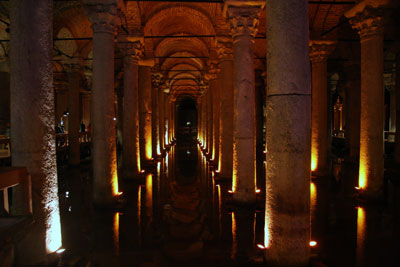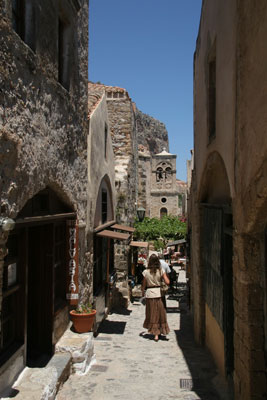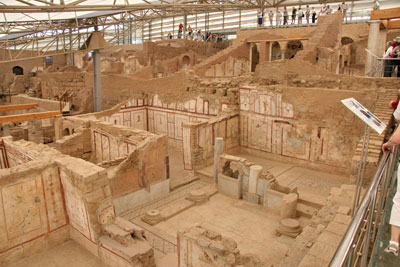Greece and Turkey — A voyage into antiquity
by Cynthia Thompson; Lebanon, NH
If you enjoy cruising on a relatively small ship, with the chance to go ashore almost every day to tour interesting sites that, frequently though not always, are archaeological in nature, then a trip on the Aegean Odyssey is the vacation for you.
The only ship of the Voyages to Antiquity cruise line, the Aegean Odyssey holds 375 passengers. I made reservations for the May 7-22, 2011, trip to the Greek Isles and Turkey through the Archaeological Institute of America (Boston, MA; 617/353-9361). One doesn’t have to be an AIA member to take part in its tours.
After signing up for the cruise, I received an attractive illustrated booklet describing the shore excursions, both included and optional, that would be offered. Once on board, all passengers were given forms to fill out to indicate which excursions they’d like to take part in. There was at least one included tour each day.
The first two nights were spent in hotels in Athens. While there, I had a chance to tour the city and the Acropolis, with its relatively new museum which has striking displays of artifacts from the nearby site. The museum’s restaurant is a pleasant place to have coffee or lunch and bask in the view of the Parthenon.
The voyage begins
I boarded the Aegean Odyssey in Piraeus, the port city for Athens. The day after embarkation, the ship docked at Nauplion (Nafplio) for a visit to Mycenae, a city which flourished between the 16th and 13th centuries BC. An optional trip to Epidaurus was offered that afternoon ($68).
Next we sailed to the southeast coast of the Peloponnese, where we visited Monemvasia, a charming medieval castle town connected to the adjacent land by a bridge. The arched entrance to Monemvasia is so narrow that everything has to be carried in by donkey or on foot! We watched visitors, who had stayed in the hotels overlooking the sea, wheeling their luggage bumpily through the cobblestone streets to catch the shuttle bus parked outside the arch.
Those of us who chose the optional full-day trip ($125) visited not only Monemvasia but also the surrounding region, including the remains of Sparta.
On subsequent days we visited the palace of Knossos on Crete (the optional full-day tour “Knossos Palace and Lassithi Plateau” cost $125) as well as the Old Town and the Palace of the Grand Masters on Rhodes. An optional afternoon tour to the acropolis at Lindos, also on Rhodes, was available for $48.
We also enjoyed the small island of Delos, the reputed birthplace of the god Apollo. It was lovely, with fields of red poppies, blue statice and other wildflowers surrounding the ruins.
Copies of the famous lion statues stand among the ruins where the originals once stood. The surviving originals are on display in the Delos Museum, one of the few modern buildings on this island of ruins.
One morning we visited the small island of Samos, the birthplace of philosophers Pythagoras and Epicurus. We toured its Archaeological Museum, where the largest freestanding kouros (statue of a male youth from the Archaic period) from the ancient world is on display. The Samos tour also included a visit to, and wine tasting at, the Samos Wine Museum.
On to Turkey
At noon that same day the Aegean Odyssey sailed on to Kus¸adası, Turkey, where we docked for the included (and much anticipated) tour of the beautiful site of Ephesus. Well known to many travelers, it would need an article of its own to do it justice.
I especially enjoyed the “terrace houses” there, which are in the process of being excavated and restored. A separate entrance fee was charged to visit them. (All fees on tours were paid by Voyages to Antiquity.)
The houses were built on a hillside, so the roof of one is the floor of the one above it, and each is set a little farther back than the one below.
Inside, we threaded our way on wooden catwalks and up multiple temporary flights of stairs to see the intricate mosaic floors and lovely wall frescoes being uncovered below. When we left the top house, we had to walk down about 60 ancient rock steps to street level to continue our tour of Ephesus.
The next day, with the ship still docked in Kus¸adası, many of us took the included full-day tour. A 2½-hour bus ride southeast through the Turkish countryside brought us to the ancient city of Aphrodisias. Larger than Pompeii, the site has many structures in very good shape, including a temple, theaters, a large stadium and others.
At the included lunch at a nearby restaurant (a choice of shish kebabs — vegetarian, fish, chicken or lamb — was offered), I discovered that the local yogurt with honey makes a delicious dessert!
Another long bus ride took us back to the ship so we could sail on to Çanakkale.
From there, we were given a choice of two included tours: one to Gallipoli, with its reminders of World War I, and one to Troy. I chose to go to Troy and was not disappointed. There was, of course, a large replica of the apocryphal Trojan horse.
Istanbul to Athens
That night we sailed up the Dardanelles to Istanbul, where we were docked for a day and a half. Both mornings offered included tours of the city highlights: the Blue Mosque, the Grand Bazaar and many others.
On the first afternoon, an optional Bosphorus cruise was available ($45). That same afternoon, our AIA group was fortunate to be able to take part in a special tour ($40) arranged by Suzanne and William Murray, our group leaders.
We took a bus through bustling Istanbul and walked into the grounds of Topkapi Palace, where we visited the Archaeological Museum with its artifacts from Troy and stunning, huge sarcophagi.
Also nearby were a museum of Mesopotamia and one displaying Turkish tiles. I visited the latter, with its beautiful walls, niches and ceilings made of colorful, historic tiles.
The final stop on our special tour was the Basilica Cistern, a vast underground structure which once held the city’s water. Now one can wander among its rows of massive columns on wooden walkways above 15 inches of water. It would be excellent during a hot summer to listen to the concerts held in that cool place!
We left Istanbul in the afternoon, and the next morning we had a chance to see (from the ship) the monasteries of Mount Athos. I am ashamed (and disappointed) to say I missed that; still sleepy, I didn’t pay attention to the 7 a.m. loudspeaker announcement that I could hear in the corridor.
In the afternoon, a 3-hour stop at the island of Skiathos gave us a last chance to shop for gifts and souvenirs.
The next morning we docked in Athens and were out of our cabins by 10 a.m. so the crew could clean up for the next group, arriving that afternoon. We waited in the Ambassador Lounge for the buses that would take passengers to the airport at the appropriate times for their trips home.
During the voyage, as well as on excursions, there were lectures delivered by well-qualified speakers on topics relevant to the sites we visited. The talks — some in the evenings, others fitting into the daytime schedule — added immeasurably to our appreciation of what we were seeing.
Life on board
I prefer not to have to pack and unpack while traveling, so cruising is perfect for me. I like to have time to relax and enjoy the ship as well as attend excursions, lectures and concerts. Interested in classical archaeology, I find the itineraries of Voyages to Antiquity particularly appealing.
I enjoyed the relatively small size of the Aegean Odyssey and found the ship comfortable. There is a formal dining room on the third deck, and on the sixth deck is a buffet-style restaurant which includes some outdoor seating. We had nice weather, and it was a treat to eat almost all meals al fresco!
The food was good and there were many choices, including vegetarian entrées. The bounteous dessert buffet always included fruit, crackers and a selection of cheese, plus a sugar-free sweet. Meals in both dining rooms were open seating.
The “dress code” was, basically, relaxed. People did dress up (though not formally) for dinner in the Marco Polo room, for the Captain’s cocktail party and on other occasions, if they chose.
One of the ship’s amenities that I took advantage of was the library filled with guidebooks, classics, such as the “Iliad” and the “Odyssey,” and lovely picture books showing the countries that the ship visits. Board games were available also.
I luxuriated in the warm outdoor Jacuzzi and made use of the computer room to send e-mail. (There is a charge for computer use.)
I also enjoyed the Sudoku and crossword puzzles available in the library; they changed daily.
Prices for this cruise ranged from $9,950 per person, double, to $4,000 for an inside single cabin. Since no outside single cabins were available when I registered, I was given an outside double on the lowest passenger deck for the price of a single, and I also received a discount as a previous traveler with Voyages to Antiquity. (I learned that 17 of us were repeat travelers.)
My price included airfare from Boston, but I did pay an additional $483 in airline departure tax and surcharges. The total cost to me was $4,829, which included two nights, with breakfast, in the less expensive of the two Athens hotels offered.
I’ve already signed up for my third Voyages to Antiquity trip (Rome to Venice, including stops in Croatia) for the spring of 2012. It, too, will be sponsored by the Archaeological Institute of America. It would be fun to meet other ITN readers on another cruise in the future!




